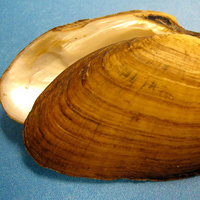Kidneyshell
Scientific name: Ptychobranchus fasciolaris

Cover photo credit: Darby Creek Watershed Board, Ohio
Status
Endangered
“Endangered” means the species lives in the wild in Ontario but is facing imminent extinction or extirpation.
Date added to the Species at Risk in Ontario List
The Kidneyshell was already assessed as endangered when the Endangered Species Act took effect in 2008. It was re-assessed as endangered in 2013.
Read the report (PDF)
What it looks like
The Kidneyshell is a medium to large freshwater mussel that grows to about 12 centimetres long. As its name suggests, the shell is kidney-shaped and is thick, solid, and smooth. It is easily recognized by its shape and by its yellow-brown shell that is scattered with regularly spaced, interrupted green rays that look like squarish green spots.
Where it lives
The Kidneyshell is typically found in small to medium sized rivers.
It prefers shallow, clear, swift-moving water with gravel and sand.
It also used to occur on gravel shoals in the Great Lakes. All mussels filter water to find food, such as bacteria and algae.
Mussel larvae are parasitic and must attach to a fish host, where they consume nutrients from the fish body until they transform into juvenile mussels that drop off of the fish.
The Kidneyshell has three known fish hosts in Canada: Blackside Darter, Fantail Darter, and Johnny Darter.
The presence of fish hosts is one of the key features for an area to support a healthy mussel population.
Where it’s been found in Ontario
In Canada, the Kidneyshell is currently found in four areas in southwestern Ontario.
There are reproducing populations in the East Sydenham River and in the Ausable River.
Small populations are also found in St. Clair River delta in Lake St. Clair and a tributary of the Thames River.
The species no longer occurs in Lake Erie or the Detroit, Thames, Grand, Welland or Niagara rivers.
View a Larger version of this map (PDF)
What threatens it
The greatest threats to the Kidneyshell are pollution and siltation, which occurs when too much soil washes into the river from nearby agricultural and urban areas.
The Zebra Mussel, an invasive species from Europe, is a serious threat because it attaches to native mussels and can kill them by interfering with breathing, feeding, excretion and movement.
Conditions that threaten the fish host species also threaten the Kidneyshell.
Action we are taking
Endangered Species and their general habitat are automatically protected
Recovery strategy
A recovery strategy advises the ministry on ways to ensure healthy numbers of the species return to Ontario.
Read the executive summary (September 10, 2010)
Read the recovery strategy (September 10, 2010)
Government response statement
A government response statement outlines the actions the government intends to take or support to help recover the species.
Read the government response statement (June 15, 2011)
Five-Year Review of Progress
A five-year review reports on progress made toward protecting and recovering a species, within five years of publishing a species’ government response statement.
Read the report on progress towards the protection and recovery of 27 species at risk, including Kidneyshell (2016).
Habitat protection
General Habitat Protection - June 30, 2013
What you can do
Report a sighting
- Report a sighting of an endangered animal or plant to the Natural Heritage Information Centre. Photographs with specific locations or mapping coordinates are always helpful.
Volunteer
- Volunteer with your local nature club or provincial park to participate in surveys or stewardship work focused on species at risk.
Be a good steward
- Private land owners have a very important role to play in species recovery. If you find Kidneyshell in a watercourse on or adjacent to your property, you may be eligible for stewardship programs that support the protection and recovery of species at risk and their habitats.
- Invasive species seriously threaten many of Ontario’s species at risk. To learn what you can do to help reduce the threat of invasive species, visit:
www.ontario.ca/invasivespecies
www.invadingspecies.com
www.ontarioinvasiveplants.ca
www.dfo-mpo.gc.ca/science/enviro/ais-eae/index-eng.htm.
Report illegal activity
- Report any illegal activity related to plants and wildlife to
1-877-TIP-SMNR (847-7667) .
Quick facts
- Kidneyshell larvae are clustered into packages called “conglutinates” when released, and somewhat resemble fish fry complete with eye spots, or insect larvae. When a fooled fish bites down on one of these packages, the larvae burst out and attach to the fish gills where they live as parasites and consume nutrients from the fish until they transform into juvenile mussels and drop off.
- Mussels are indicators of environmental health. Since they have complex life cycles, are long-lived (some species can live up to 100 years!) and feed by filtering water and its pollutants, mussels can provide a snapshot of how healthy our waterways are.
- Aboriginal people harvested mussels for food and to create jewelry and tools. In the 1800s, massive numbers of mussels were harvested from the Grand River to create buttons. Millions were shipped out every year until the 1940s when plastic buttons became more popular.
